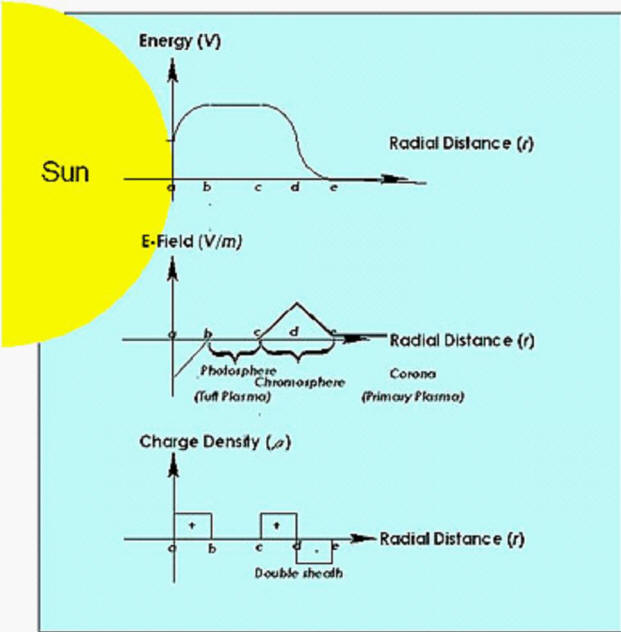|
|
Impulse Control
Oct 09, 2009
Magnetic reconnection events in
miniature are said to heat the Sun's
corona. As usual, there is no
mention of Kristian Birkeland's
great discoveries.
Heliophysicists do not know why the
temperature of the Sun's corona is
millions of degrees hotter than the
surface. Based on the thermonuclear
fusion model, as distance from the
surface increases the temperature
should decrease. It is a matter of
simple thermal emission mechanics:
temperature decreases with the
square of the distance.
According to a
press release from the Goddard
Space Flight Center's Solar Physics
Laboratory, scientists have
determined why: "nanoflares."
According to astrophysicist James
Klimchuk: "They [nanoflares] occur
within tiny strands that are bundled
together to form a magnetic tube
called a coronal loop."
Within the magnetic filaments, as
the theory suggests, small bursts of
impulsive energy from the
"reconnection" of "unresolved
strands" inside the coronal loops
are responsible for heating the
corona.
It has long been thought that the
corona's multimillion degree
temperature resulted from continuous
or "steady" heating, as previously
mentioned. That hypothesis would see
coronal loops of a certain
temperature as having a specific
density. Observations by the Hinode
satellite indicate that coronal
loops are of substantially greater
density than earlier proposals
assumed, however.
In an Electric Universe, the
"anomalous" density found in coronal
loops, along with the unexplainable
10 million degree Celsius
temperature of the corona—compared
to the 5000 degree Celsius
temperature of the surface (the
photosphere)—is easily explained
when Birkeland currents are
considered.
An electric current creates a
magnetic field (the stronger the
current, the stronger the magnetic
field). In some regions of the
photosphere, horseshoe-shaped
magnetic loops of plasma extend for
thousands of kilometers out through
the chromosphere. It has been
recently discovered that those
coronal loops are made up from
bundles of rotating tubes. Those
"flux tubes" are Birkeland currents.
Within Birkeland currents,
electrical activity creates charge
separation, forming what Hannes
Alfvén called "double layers" in the
plasma. A principle aspect of
Birkeland currents is that they
follow magnetic fields.
Powerful currents create an
electromagnetic torus that causes
the coronal loops to grow. If the
current flow in the loop increases
beyond a certain limit, the double
layer will be destroyed, causing the
energy stored in it to explode with
tremendous force. So, rather than a
new idea, nanoflares are a
misinterpretation of Birkeland
current filaments.
There is a certain amount of
confusion when it comes to any
theory of solar behavior that does
not include electrical activity.
Failing to recognize the fundamental
structure of coronal loops and how
they correspond to the
electromagnetic behavior of
Birkeland currents (the "strands"
described by Klimchuk, et al.) has
led to another ad hoc mechanism
designed to preserve the legitimacy
of theories whose time has long
since passed.
It is not the intention of Picture
of the Day articles to engage in
bitter opprobrium, or to unduly
criticize those who make their
living in conventional science.
However, the institutionalized
dismissal of important foundational
work by Kristian Birkeland and
Hannes Alfvén deserves criticism.
Their experiments in the laboratory,
as well as their field work, led to
a consistent and more appropriate
hypothesis: it is electricity that
powers the Sun and not internal
nuclear fusion reactions.
Written by Stephen Smith from an
idea suggested by Jim Johnson
|
|
|
|
|
|
SPECIAL NOTE - **New Volumes Available:
We are pleased to announce a new
e-book series
THE UNIVERSE ELECTRIC. Available now, the first volume
of this series, titled Big Bang, summarizes the failure of modern cosmology
and offers a new electrical perspective on the cosmos. At
over 200 pages, and
designed for broadest public appeal, it combines spectacular
full-color graphics with lean and readily understandable
text.
**Then second and third volumes in the series are now available,
respectively titled Sun and Comet, they offer
the reader easy to understand explanations of how and why these bodies
exist within an Electric Universe.
High school and college students--and teachers in
numerous fields--will love these books. So will a large
audience of general readers.
Visitors to the Thunderbolts.info site have often
wondered whether they could fully appreciate the Electric
Universe without further formal education. The answer is
given by these exquisitely designed books. Readers from
virtually all backgrounds and education levels will find them
easy to comprehend, from start to finish.
For the Thunderbolts Project, this series is a milestone.
Please see for yourself by checking out the new
Thunderbolts Project website, our leading edge in
reaching new markets globally.
Please visit our
Forum
|
|
|
|
|
|
|
|







